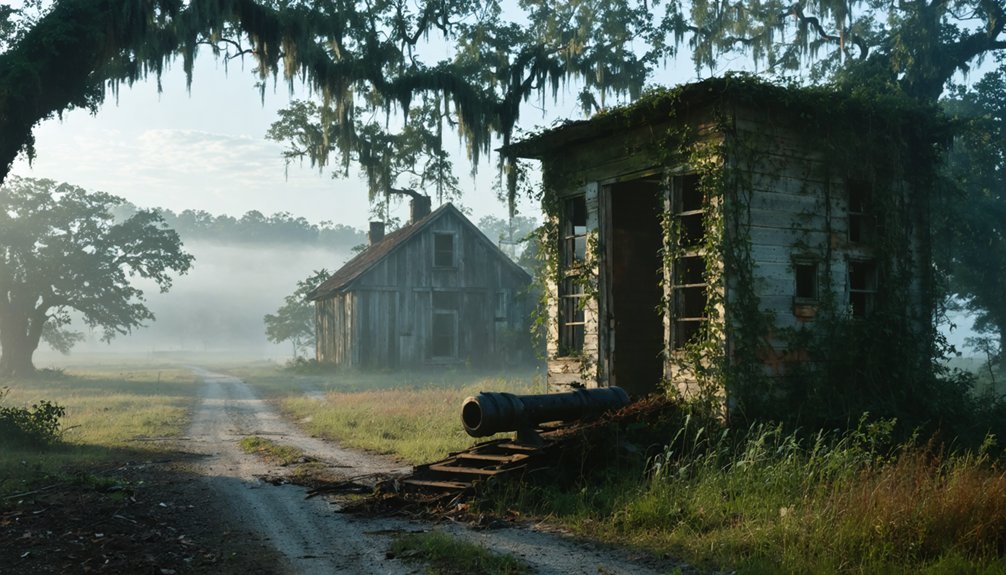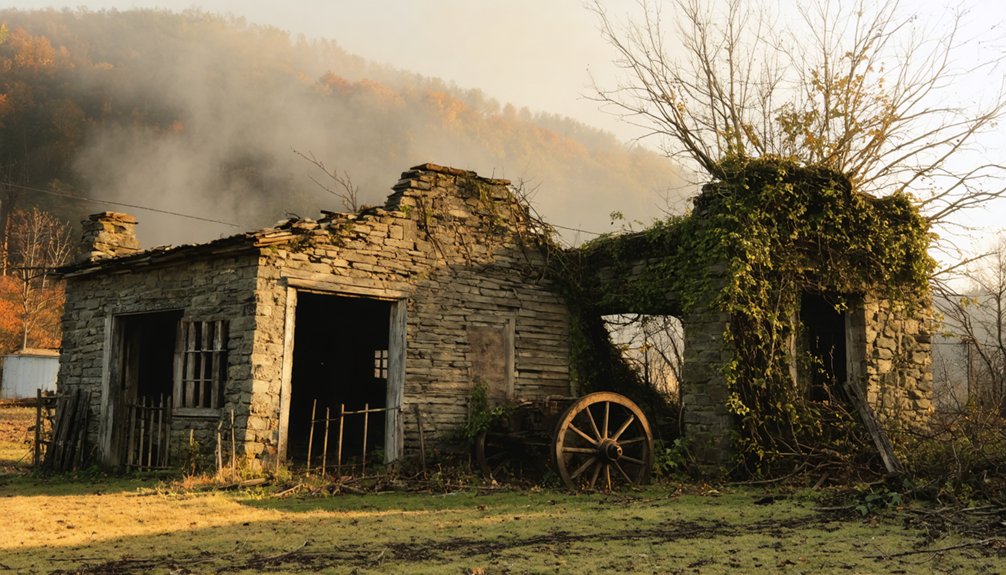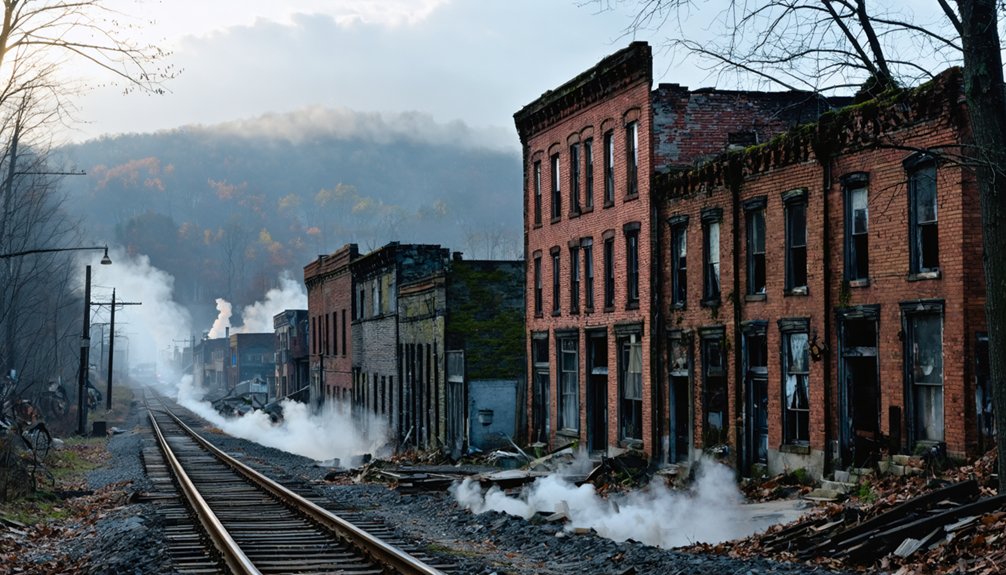You’ll find America’s most haunting Civil War villages frozen in time, from Alabama’s moss-draped Cahawba to the mysterious Feltville Historic District. Explore Fort Delaware’s prison walls where 33,000 Confederate soldiers once languished, or venture through Dogtown’s numbered cellar holes marking Revolutionary War widows’ homes. Discover draft dodgers’ hidden mountain settlements and crumbling coastal fortifications like Fort Wetherill. These abandoned places hold untold stories of triumph, tragedy, and those who never left.
Key Takeaways
- Cahawba, Alabama’s first capital, transformed from a bustling cotton trade center to a haunting Civil War prison site housing Union soldiers.
- The Feltville Historic District contains eight ghost-town structures, including abandoned houses where mysterious disappearances occurred in 1912.
- Fort Delaware imprisoned 33,000 Confederate soldiers, with reported ghostly encounters and unexplained phenomena continuing to this day.
- Draft dodger settlements in caves and mountains across the South remain as eerie reminders of Civil War resistance.
- Harrisburg’s weathered stone walls and foundations stand as silent witnesses to pioneer life abandoned during the 1860s.
The Lost Capital: Cahawba’s Moss-Covered Legacy
While political intrigue shaped Alabama’s early statehood, the ambitious founding of Cahawba as the state’s first capital in 1820 marked a pivotal moment in Southern history.
You’ll find echoes of its brief glory in the brick capitol building that once stood proudly at its center, surrounded by elegant homes and hotels at the meeting point of two mighty rivers.
Cahawba’s significance extended beyond politics – it was a complex society where enslaved communities made up two-thirds of its 2,000 residents by 1860.
These laborers worked the surrounding plantations while the town flourished.
Steamboats carried cotton to Mobile during the 1840s, bringing prosperity to local merchants.
The town later became a key Civil War site, housing the infamous Castle Morgan prison where countless Union soldiers were held captive.
But political rivalries soon ended Cahawba’s reign as capital, with its power shifting to Tuscaloosa by 1825.
Despite claims of flooding dangers, it was backroom dealings, not water, that sealed its fate.
Dogtown: A Refuge for the Forgotten
Deep within Cape Ann’s rocky terrain, you’ll find the haunting remnants of Dogtown, a once-thriving colonial settlement established in 1642 as the Commons Settlement. This forgotten refuge evolved from a prosperous farming community into a haven for Revolutionary War widows and society’s outcasts.
You’ll discover traces of about 60 widows who once called this five-square-mile settlement home. As you explore the preserved archaeological site today, you’ll encounter numbered cellar holes marking former homesteads, where residents once survived on foraged berries and peat fuel. By 1814, only six original houses remained standing in the rapidly declining village. Today, Dogtown serves as a heritage tourism site, drawing visitors interested in its unique colonial history.
The settlement’s legacy lives on through inspirational messages carved into boulders, silent tributes to those who sought shelter in these rocky hills. While Dogtown’s isolation ultimately led to its abandonment by the early 19th century, its spirit of resilience endures.
Feltville’s Enchanted Forest and Empty Houses
Within New Jersey’s historic Watchung Reservation lies another ghostly reminder to America’s abandoned past – the haunting Feltville Historic District.
As you venture into the Enchanted Forest surrounding this deserted village, you’ll discover eight surviving houses, a church, and a carriage house slowly being reclaimed by nature.
Your ghostly exploration will reveal:
Venture into Feltville’s mysterious ruins, where weathered walls and darkened doorways whisper stories from centuries past.
- Stone walls and foundations hidden beneath centuries-old trees
- Empty worker duplexes where 175 residents once thrived before the village’s decline
- The infamous “last house” where three young girls allegedly vanished in 1912
- Trails leading to secluded spots where visitors report whispers and apparitions
Once a bustling mill town and summer resort, Feltville’s ghostly legends now echo through its empty corridors, making it a haunting memorial to America’s forgotten communities.
Like the lumber town of Falk, California that saw its decline in the 1920s, Feltville gradually faded into abandonment as industry and transportation changed.
Only three families remain as permanent residents, while the rest stands frozen in time.
The village traces its origins to 1845 when David Felt purchased 660 acres to establish his printing business and create a self-contained industrial community.
Fort Delaware: Where Spirits Roam the Prison Walls
You’ll find Fort Delaware‘s somber stone walls harboring the echoes of over 33,000 Confederate prisoners who endured brutal conditions, disease outbreaks, and a staggering 7.6% death rate during the Civil War.
Within these weathered fortifications, you might encounter unexplained footsteps in abandoned tunnels, shadowy figures darting through former prison cells, and the phantom sounds of cooking utensils clanging in the kitchen where countless meals were prepared for inmates. The imprisoned soldiers survived on two daily meals of hardtack, small meat portions and bean soup, though some could purchase extra food to supplement their rations. Visitors can reach this haunting fortress only by taking a scenic ferry ride from Delaware City.
Walking through the restored military compound today, you’re stepping into a perfectly preserved slice of Civil War history where the spirits of soldiers, guards, and prisoners are said to maintain their eternal watch over Pea Patch Island.
Prison Life and Death
Standing as a grim indication to Civil War imprisonment, Fort Delaware housed over 33,000 Confederate prisoners between 1862 and 1866, with its population peaking at 12,596 inmates in 1863.
Inside these stone walls, prisoners endured harsh conditions that would later spark ghostly encounters reported by visitors today. You’ll find evidence of their struggle in every corner of the facility:
- Disease and overcrowding claimed 2,500 lives, with bodies laid to rest at Finn’s Point Cemetery across the Delaware River.
- Desperate prisoners attempted daring escapes, including one who concealed himself in a coffin bound for burial.
- Living quarters separated enlisted men in wooden “bull pen” barracks from officers housed within the fort.
- Rations dwindled by 1864 as the War Department retaliated against Southern POW camp conditions.
The first Confederate inmates arrived after being captured at Gettysburg, marking the beginning of the fort’s dark history as a prison.
With just 300 Union soldiers guarding the massive prison population, escape attempts became increasingly common despite the challenging terrain and conditions.
Ghost Stories After Dark
As darkness blankets Pea Patch Island, Fort Delaware transforms into a paranormal investigator’s paradise, where the Diamond State Ghost Investigators (DSGI) lead visitors through dimly lit corridors armed with K2 electromagnetic field detectors and infrared cameras.
You’ll encounter the mysterious “blue man” specter and possibly feel the touch of shadow people who dart through the tunnels and doorways.
In the officer’s quarters, you might witness the ghostly children’s spirits, marked by an eerily moving rocking horse and small figures in empty beds.
The kitchen harbors Susan’s apparition, accompanied by phantom cooking sounds.
Confederate prisoners who perished here still make their presence known through spectral sightings and ghostly encounters – their desperate escape attempts and suffering eternally echoing through the fort’s brick walls.
Military History Preserved
Today, Fort Delaware stands as a monument to Civil War military history, preserved as a state park where visitors can explore the same corridors that once held 33,000 Confederate prisoners.
Through dedicated preservation efforts, you’ll discover authentic military artifacts and restored fortifications that tell the complex story of this infamous prison camp.
Walk through the carefully preserved spaces where history unfolded:
- The “bull pen” barracks where enlisted prisoners endured harsh conditions after 1863
- The L-shaped guard quarters, built to identical specifications as the prisoner housing
- The fort’s interior chambers where high-ranking officers were detained
- The hospital facilities, once considered among the military’s finest
You’re witnessing more than a fortress – you’re experiencing a meticulously maintained symbol to both the triumphs and tragedies of America’s most divisive conflict.
Fort Wetherill’s Silent Watch Over Narragansett Bay
Perched atop dramatic 100-foot granite cliffs on Conanicut Island, Fort Wetherill has maintained its strategic vigil over Narragansett Bay since 1776, when American colonists first established the Battery on Dumpling Rock.
During World War I and II, this coastal artillery fortress stood as one of New England’s most formidable defenses, armed with massive 12-inch rifles and an intricate network of underground bunkers.
Fort Wetherill’s imposing gun batteries and maze-like bunker system made it a cornerstone of coastal defense during both World Wars.
Today, you’ll find ghostly sentinels in the form of abandoned gun emplacements and crumbling concrete bunkers.
Since its decommissioning in 1946, nature has slowly reclaimed the 61.5-acre site, where graffiti-covered walls and overgrown tunnels beckon urban explorers.
As you navigate the narrow corridors with your flashlight, you’ll discover the circular battery mounts and ammunition tracks that once helped protect America’s freedom.
Harrisburg: The Ghost Town Along Interstate 15

As you traverse Interstate 15 through Utah’s Washington County, you’ll find the remnants of Harrisburg, where Moses Harris and fellow Mormon pioneers established their settlement in 1859 amid the convergence of the Virgin River and Quail Creek.
You can still glimpse the weathered stone walls and foundations that once housed 200 resilient settlers who carved out their existence through farming, community building, and steadfast faith.
Walking among these ruins today, you’ll discover the preserved Orson B. Adams House standing as a memorial to the pioneer spirit that flourished here before natural disasters and grasshopper plagues forced the town’s abandonment by 1895.
Pioneer Life Before Abandonment
While Harrisburg thrived during the 1860s as a small Mormon settlement, its pioneer residents faced the harsh realities of frontier life along Utah’s Virgin River.
You’d find these resilient settlers working the challenging soil, building stone cottages, and fighting to maintain their independence in the rugged landscape where the Mojave Desert meets the Colorado Plateau.
The pioneer struggles were evident in their daily routines:
- Living in modest stone homes crafted from local rock
- Practicing subsistence farming despite poor soil conditions
- Drawing water from Quail Creek and Virgin River for irrigation
- Trading locally produced goods and crafts for essential supplies
The community’s spirit of self-reliance persisted even as they battled environmental hardships, from devastating floods to grasshopper plagues that threatened their crops and livelihoods.
From Settlement to Ruins
The once-vibrant pioneer settlement of Harrisburg began its slow descent into abandonment during the 1860s, when a devastating flood forced residents to relocate from their original Harrisville site.
Despite reaching a peak population of 200 settlers by 1868, the town’s resilience would be tested by relentless environmental challenges.
You’ll find that pioneer struggles intensified as drought ravaged crops, grasshopper swarms decimated food supplies, and tensions with Native American groups created an atmosphere of instability.
By the 1870s, these cumulative hardships triggered a steady exodus of residents.
What was once a promising settlement gradually transformed into weathered stone ruins.
Today, as you drive along Interstate 15, you’ll see the last remnants of this frontier town, with the restored Orson B. Adams Home standing as a silent memorial to those who dared to settle here.
The Secret Hideaways: Civil War Draft Dodger Settlements
During America’s bloodiest conflict, numerous clandestine settlements emerged across North America, offering sanctuary to those unwilling or unable to fight in the Civil War.
These draft dodger settlements ranged from Canada’s Skedaddler’s Ridge to hidden communities deep within Southern territory.
You’ll discover these remarkable havens of resistance took many forms:
- Cave dwellings in Mississippi and Louisiana, where “cave-dwellers of the Confederacy” found shelter near the Pearl River
- Armed “Brush Men” camps in North Central Texas, defying Confederate authorities
- Mountain refuges scattered through Arkansas, Tennessee, and North Carolina
- Skedaddler’s Ridge in New Brunswick, where by December 1863, some 50 Americans had established a new life
These settlements represented more than mere hiding places—they were symbols of individual conscience against the tide of war.
Abandoned Military Outposts of the American South

Beyond the hidden havens of draft dodgers, another set of Civil War relics dots America’s southern landscape – military outposts that once stood as bastions of power and strategic might.
You’ll find Fort Craig‘s weathered remains along the Rio Grande in New Mexico, where Union and Confederate forces first clashed in 1862. Not far away, Fort Selden’s ruins still guard the historic El Camino Real, its adobe walls echoing tales of Buffalo Soldiers who once patrolled its grounds.
In Tennessee, Fort Defiance‘s earthen walls, built by enslaved hands, stand as a somber reminder of forced labor and military strategy. Each abandoned outpost tells its own story – from Fort Barrancas’ brief Confederate occupation in Florida to the burned remnants of El Pueblo Fort in Colorado, where traders once bartered under the western sky.
The Last Residents: Stories of Those Who Stayed Behind
Long after bustling streets fell silent and commerce ceased, scattered individuals remained in America’s Civil War ghost towns, becoming unlikely guardians of these abandoned places.
Among these forgotten legacies, you’ll find tales of resilient souls who refused to leave their ancestral grounds, even as nature reclaimed the ruins around them.
Through crumbling walls and overgrown paths, stubborn guardians remained, watching over the memories their ancestors left behind.
- In Cahawba, Alabama, freed African Americans transformed the abandoned courthouse into a beacon of political hope, holding meetings in its hollow halls.
- Black Neil of Dogtown stood as the last sentinel until exposure forced his departure, leaving only ghostly encounters in his wake.
- Former slaves and caretakers maintained crumbling estates, tending to family graves long after others fled.
- At Castle Morgan Prison Camp, though no permanent residents remained, the spirits of 3,000 Union prisoners seem to linger in local lore.
Preserved in Time: Archaeological Sites of the Civil War Era

You’ll find haunting reminders of the Civil War era in battlefield ruins that still stand sentinel across the American landscape, from earthen fortifications at Kennesaw Mountain to the preserved trenches of Camp Lawton.
Today’s archaeological discoveries continue to unearth underground secrets through systematic surveys and careful excavation, revealing everything from soldiers’ personal effects to military equipment that lay hidden for over 150 years.
Each artifact tells its own story – from bullet-riddled trees that mark fierce firefights to household items that speak of civilian life upended by war – allowing you to piece together the complex human drama of this pivotal period in American history.
Battlefield Ruins Still Standing
While time has weathered many Civil War battlefields into distant memories, several remarkable sites stand as proof of the conflict’s enduring presence.
You’ll find battlefield preservation efforts have maintained original earthworks, pioneer cabins, and battle-scarred landscapes that whisper tales of American valor and sacrifice.
At these haunting locations, archaeological findings continue to surface, revealing the raw reality of soldier life:
- Pickett’s Mill Battlefield showcases pristine 19th-century roads and fortifications
- Authentic trenches and rifle pits remain visible across preserved terrains
- Battle-worn structural ruins serve as focal points for military history museums
- Original earthworks allow you to walk the same ground where soldiers once stood
These sites aren’t just preserved land—they’re tangible connections to a pivotal era in America’s quest for unity.
Underground Secrets Revealed Today
Beneath the weathered soil of former Civil War camps and battlefields, archaeologists continue to unearth remarkable secrets that reshape our understanding of 1860s military life.
You’ll find evidence of hidden structures like Crimean Ovens, ingenious underground heating systems that once warmed Union hospital tents during bitter winters. Every five centimeters they dig, researchers uncover archaeological discoveries that tell your ancestors’ stories – from bottle fragments and bloodstained buttons to coded messages and collapsed tunnels.
These sites reveal how soldiers adapted to harsh conditions, with remnants of hearths and refined ceramics painting a picture of daily camp life.
When you visit preserved locations today, you’re walking above a complex network of forgotten features – each artifact and foundation sharing whispered tales of America’s most pivotal conflict.
Historical Artifacts Tell Stories
These silent sentinels of history – the preserved Civil War sites across America – stand as open-air museums, each telling intricate stories through their carefully excavated artifacts.
Through meticulous artifact analysis, you’ll discover the raw truth of the conflict etched into every recovered item. The historical narratives emerge from:
- Bloodstained uniform buttons and sealed letters revealing intimate soldier experiences
- Lead canister fragments and grapeshot patterns mapping precise troop movements
- Personal effects like annotated rosters documenting the harsh realities of war
- Hidden messages and coded documents uncovering previously unknown military strategies
At sites like Fort Sumter and Vicksburg, you can walk among original cannons and reconstructed trenches where advanced archaeological methods have peeled back layers of time, exposing the authentic voices of those who fought for their beliefs.
Frequently Asked Questions
Are There Any Documented Cases of Treasure Being Found in These Villages?
You’ll find over 300 documented treasure hunting discoveries, including Franklin’s farmer who unearthed Civil War-era artifacts, and Fort Selden’s gold coins and pocket watch hidden in historical artifacts.
What Survival Equipment Should Visitors Bring When Exploring These Abandoned Sites?
You’ll need survival gear including sturdy boots, gloves, helmet, flashlight, first-aid kit, maps, and emergency supplies. Don’t forget safety precautions like marking tape and communication devices for protection.
Which Seasons Offer the Best Conditions for Paranormal Investigations?
Like autumn leaves revealing secrets, fall’s crisp air and winter’s hushed chill offer you ideal investigation conditions. You’ll find clearer evidence, stable equipment performance, and minimal interference between September and February.
How Did Local Native American Tribes Interact With These Settlements?
You’ll find complex cultural exchanges marked by both trade and tension. Native tribes initially maintained historical dependencies with settlers, but growing conflicts over land rights led to forced displacement and distrust.
Were Any Famous Historical Figures Known to Visit These Locations?
Like shadows from the past, you’ll find Civil War titans Lincoln, Grant, and Sherman walking these ghostly grounds. Lee, Jackson, and countless other historical figures traversed these haunted settlements.
References
- https://www.loveexploring.com/gallerylist/131658/abandoned-in-the-usa-92-places-left-to-rot
- https://en.wikipedia.org/wiki/Wikipedia:WikiProject_Ghost_towns
- https://www.businessinsider.com/abandoned-places-us-states-2018-4
- https://www.youtube.com/watch?v=ZAay8y6iHDY
- https://www.geotab.com/ghost-towns/
- https://en.wikipedia.org/wiki/Ghost_town
- https://www.thetravel.com/us-ghost-towns-that-are-still-abandoned/
- https://www.mentalfloss.com/geography/wanderlust/creepiest-ghost-towns-united-states
- https://en.wikipedia.org/wiki/List_of_ghost_towns_by_country
- https://www.lovemoney.com/gallerylist/86648/americas-empty-ghost-towns-and-why-theyre-abandoned-today



